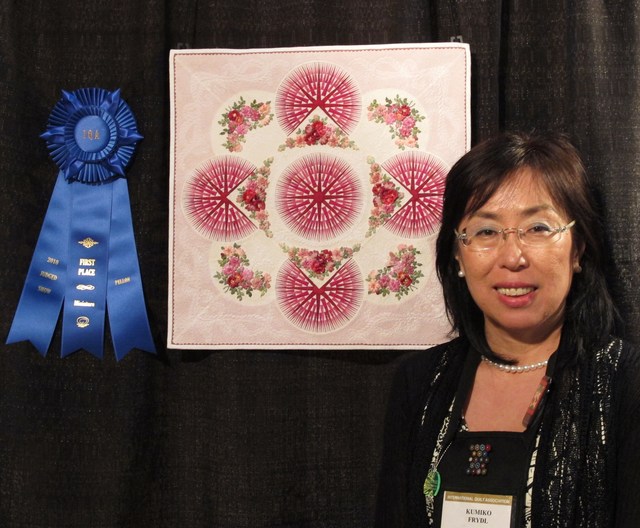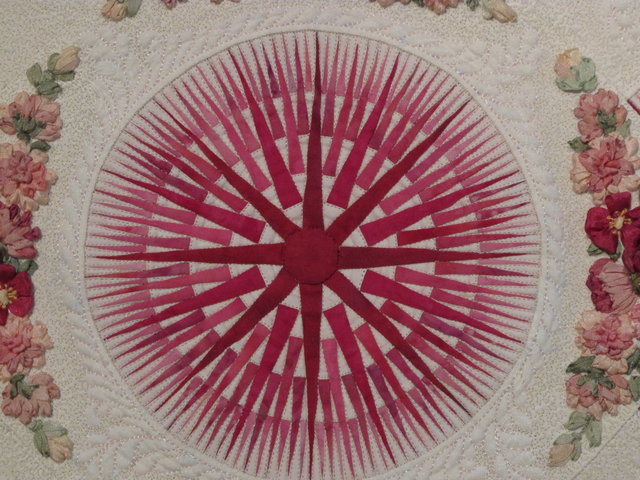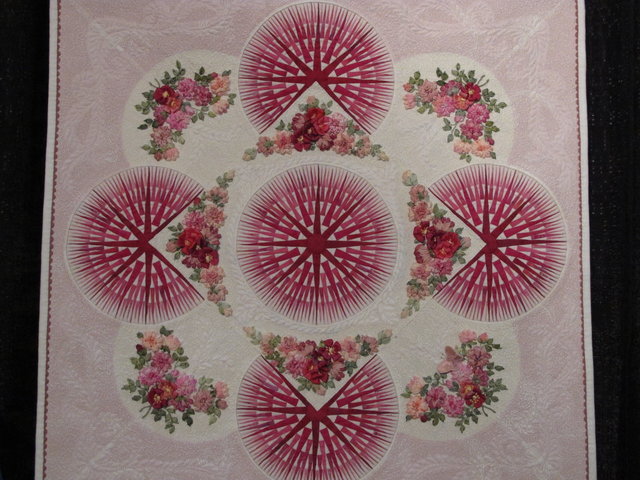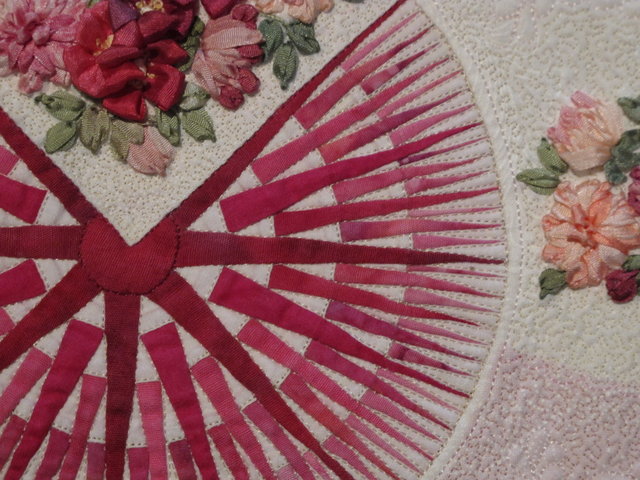
It's All in the (Minute) Details by Lilo Bowman
Every so often, as I walked through the rows of outstanding quilts at this year's International Quilt Festival in Houston, I had the feeling that a certain quilt was calling out to me for closer inspection. Such was the case with Mission Impeccable by Kumiko Frydl (shown above). This astounding miniature (16 3/4" x 16 3/4"!) quilt required 10 - 12 hours of work a day over a four-month period, but it was not the first time Kumiko created this design. In fact, this diminutive beauty is the third quilt in a series, each one tinier than the last. No doubt, Kumiko is a quilter who loves to challenge herself!
While working with miniature quilts is not where Kumiko began, working with fine details is something that has attracted her for a long time. As a graduate student studying commercial arts at Tokyo University, Kumiko spent many hours at her drafting table. When not studying for her degree, she enjoyed sewing many of her own clothes. With a father in the textile industry, she had a great opportunity to utilize the fabrics available to her. As fate would have it, when she met and married her husband, his job required a move to England, and Kumiko naturally came along.
England, she quickly discovered, was a bit limited in fabric selection, and the price of those available fabrics was very high. Also, the couple's small apartment did not include space for working on large sewing projects. It was time for Kumiko to reassess her situation. She began to study quilting on her own, but later joined a guild where she was taught many new skills by the members. It was also during this time that she began making bobbin lace.

Bobbin lace making. Courtesy of Wikipedia.org
Bobbin lace is made by tacking a paper pattern to a small, firm pillow. Each thin bobbin is wound with a length of thread, and the lace is created by twisting and winding the individual threads around pre-placed pins to follow the pattern. Depending upon the design, as many as several dozen bobbins may be required. While this particular craft may not appeal to those who don't care for intricate, detailed work, it was perfect for Kumiko.
Following several more moves, Kumiko found herself in Houston, TX. By this time, she had become quite proficient in quilting and wanted to try her hand at making even more challenging pieces. In 2007, she fell in love with a quilt she saw on the cover of Quilter's Newsletter Magazine. The quilt, made by Kathy Nakajima, was called Sunshine Rose Garden, and while Kumiko was drawn to it, she did not simply want to copy Kathy's original design. Instead, Kumiko decided to make her version in miniature, replacing the appliqued elements with silk-ribbon embroidery. This smaller version became Mission Impossible? and measured a tiny 20" x 20" in size. To her surprise, the quilt won a First Place ribbon in the miniature category. 
Now Kumiko was challenged make even smaller quilts. Two more versions have been completed with Mission Impeccable, measuring a mere 16 3/4" x 16 3/4", the smallest to date...and another First Place winner in the miniature category in Houston in 2010.
The central Mariner's Compass in this tiny quilt is made up of 128 individual spokes. At 1/20th the size of the original, there was no room for error in the paper-piecing process, Kumiko explains. With such a small project, she generally sews with 18 - 23 stitches per inch. She describes herself as stubborn, and says that she does not give up until she has perfected each element. Such dedication means that she often works 10 -12 hours every day without fail when a deadline is looming.

Notice the clusters of hand-embroidered silk-ribbon flowers that surround the central compass. Kumiko designed the flowers to represent the appliqued ones in the original inspiration quilt.

All of the free-motion quilting in this quilt was done with YLI 100% silk thread in the top and Superior Masterpiece thread in the bobbin. For this detailed work, Kumiko likes to use a Microtex 60 needle. The quilt is made from100% pre-washed cotton and hand-dyed cotton, and Kumiko drafted the entire design on Golden Threads paper. Not surprisingly, given her background, she finds the drafting the most enjoyable part of the entire process.

As she designs mostly for competition, Kumiko doesn't have a great deal of time for other projects. While you might think that a miniature quilt takes less time, that is not necessarily the case. You might be surprised to know this piece alone took around four months to complete, and chances are that it required just as much patience and stubborness to complete as its larger counterpart.
So the next time you walk through a gallery of miniature quilts, step in for a closer look. Better yet, bring a magnifying glass. You just might be surprised at what you discover.




.jpg)


